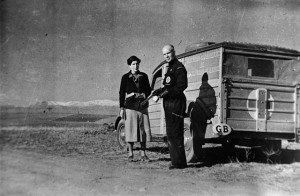“Modern medicine has less need of great doctors and famous surgeons than of clear-thinking, far-sighted statesmen.”
- Norman Bethune
Dr. Norman Bethune (1890-1939) is perhaps best known for his medical work done in Spain during the Spanish Civil War (1936) and in China during the Second Sino-Japanese War (1938-39). His experiences as a war veteran, as a survivor of tuberculosis and as a thoracic surgeon helped shape his progressive politics. With his inventive nature and adventurous spirit, Bethune always believed in bringing medical care to those who needed it the most, whether on the battlefield or in poorer neighbourhoods. A true man of action, Dr.Bethune fought injustice on several fronts and dedicated himself to improving the condition of his fellow man.
While deployed as a stretcher bearer in WWI (Ypres), Bethune saw first hand how crucial immediate medical treatment was needed at the front. After he was wounded, he returned to Canada and obtained his M.D. in 1916. In the 20’s, after a stint in the Royal Navy, Bethune opened up a private practice in Detroit, Michigan. While working long hours with the poor, often free of charge, Bethune contracted TB.
His chances for recovery seemed slim until he was admitted to the Trudeau Sanatorium in Sarnac Lake, New York. Here, he read about a radical new treatment for TB called pneumothorax, which involved collapsing the lung so that it can heal. Only 13 doctors in the world were familiar with this technique, one of which was Dr. William Edward Archibald from Montreal. Bethune insisted on having the procedure done and he recovered. Thereafter, he studied under Dr. Archibald and practiced thoracic surgery in Montreal and Carterville. His innovations in the field of thoracic medicine include the invention or redesign of 12 medical and surgical instruments between 1929 and 1936. The Bethune Rib shears are still in use today.

Scapula Lifter and Retractor Instrument invented by Bethune (Image: Library and Archives Canada, PA-160616)
Montreal during the Great Depression had no shortage of TB patients. Bethune treated many people successfully, but he realized that his underprivileged patients would often return because they lived in harsh living conditions and without proper medical care. He believed that access to medical treatment was a social justice issue and became very vocal about regulating private medical practice so that everyone would be given the same level of healthcare regardless of their economic circumstances.
He traveled to the Soviet Union in 1935 to attend an international medical conference. While there, his observations of the Soviet health care system made a deep impression on him. Upon his return to Canada, Bethune joined forces with like-minded doctors, nurses and social workers and formed the Montreal Group for the Security of People’s Health in 1936, with the goal of promoting socialized medicine. The Canadian government met his ideas with either rejection or indifference. Many of his medical colleagues distanced themselves because they saw his political views as too radical. It was also at this time that Bethune joined the Communist party. A committed anti-fascist, Bethune readily accepted an invitation from the Committee to Aid Spanish Democracy to head the Canadian Medical Unit in Madrid. He left for Spain in November 1936 as a volunteer member of the Mackenzie-Papineau Battalion.
On the frontlines the Spanish Civil War, Bethune developed his most innovative medical invention: the mobile medical unit. He realized that many soldiers died because of shock due to blood loss while en route to the base hospitals. In order to provide blood transfusions to the wounded, Bethune set up a blood bank close to where the fighting was taking place. He then outfitted wagons with a refrigerator, sterilizer, incubator, lamps, flasks, blood transfusion sets, and stored blood. Within 6 months, Bethune’s team was administering up to 100 transfusions a day. This important medical innovation saved several lives in Spain and China and formed the basis for the Mobile Army Surgical Hospital (MASH).
When the Japanese invaded China in 1937, Bethune saw another opportunity to fight fascism. He put together another medical team and left for the Shanxi-Hobei

Bethune with Mobile Medical Unit in Spain, 1936 (Image: Library and Archives Canada, PA-117423)
border region of China to join the 8th Route Army in January 1938. While working in extremely difficult conditions, Bethune continued to practice surgery and dedicated himself to training his Chinese colleagues. He continued to use his mobile medical units, leading them on horseback over mountains and plains. Most of the time, Bethune and his team were seldom further than three miles away from the thick of the fighting.
His health deteriorated significantly while in China due to overwork and lack of resources. Just before he planned to return to Canada to receive medical treatment and to raise money for his work, he was called to the operating theatre. There he cut his finger and died from a resulting infection on November 12, 1939.
The Chinese regard him as national hero thanks to an essay written by Mao Zedong entitled In Memory of Norman Bethune describing Bethune’s efforts. His tomb can be found at the Revolutionary Martyrs’ Cemetery Shijiazhuang, Hebei Province, China. In 2004, the Centro Andaluz de la Fotografia in Spain created an exhibition chronicling Bethune’s efforts during the Spanish Civil War. His childhood home in Gravenhurst, Ontario was turned into a museum called The Bethune Memorial House in 1976. Montreal established the Place Norman-Bethune, which houses a statue donated by China and is located across the street from Concordia University. He will be remembered in Canada as an ardent supporter of universal healthcare and a medical genius.
